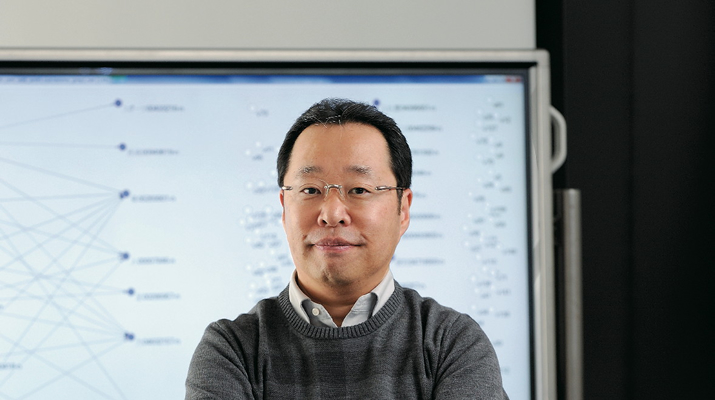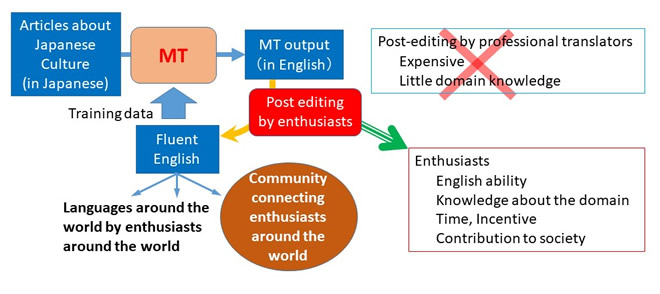
ここからコンテンツです。

The Progress of Machine Translation and How it Changes the World
By Hitoshi Isahara
We aim to strengthen Japanese companies competitiveness in global industry and increase the number of visitors to Japan, by implementing machine translation technology in society. We are currently working with collaborating companies on a system that assists with the translation of uncommon words, which is one issue plaguing AI-powered machine translation, and a method that can realize high-performance machine translation from a small amount of bilingual data.
In the last couple of years, machine translation has vastly improved in accuracy as a result of the development and release of artificial intelligence systems (neural machine translation systems). Their output is now almost perfect, and is even said to be at the same level as human translation. However, machine translation requires a large amount of bilingual text, it can still produce omissions and errors, and words that are not used very often such as proper nouns are often mistranslated. As a result, machine translation is still a flawed tool, and the world’s researchers are striving to fix its problems.
As one method to solve the problem of mistranslating proper nouns, we are looking into a method that treats a character string, instead of a word, as one unit. As a result, we have developed a method that can translate proper nouns while simultaneously using information on character strings and morphemes [1]. We have also developed a method that can realize high-performance machine translation from even a small amount of bilingual data in individual fields. In fields for which not a lot of bilingual data has been produced, we have developed a method that involves first using the translation results of an existing commonly-used translation system to then create a machine translation system for a specific field. If a human manually edits the machine translation output, the system tries to post-edit [2] using cloud based volunteer support, and translation results improve.

For a long time, we have conducted collaborative research on the implementation of machine translation in cooperation with airline companies and automotive companies [3]. Making use of the great improvements made to the accuracy of neural machine translation, we have begun the implementation of this technology into society through collaboration with corporations by co-developing a new service that utilizes machine translation technology, providing translation technology for multilingual information services aimed at foreign visitors to Japan, and providing technological support for improving translation systems.

Incorporating highly powerful machine translation systems into everyday life will make it possible, in the industrial world, for example, to provide information on products and services in different languages and achieve overseas expansion that was previously not possible. In the tourism sector, it will become possible to provide information on areas and establishments which are not widely known overseas to hopefully increase the number of tourists visiting Japan. This technology will also benefit foreign residents in Japan by providing them with information that was previously only available in Japanese in different languages.
References
- [1] Nakamura N. and H. Isahara. “Effect of Linguistic Information in Neural Machine Translation”, ICAICTA 2017 - International Conference on Advanced Informatics: Concept Theory and Applications, Bali, Indonesia, August 16 - 18, 2017
- [2] Aikawa, T., K. Yamamoto, and H. Isahara. “The Impact of Crowdsourcing Post-editing with Collaborative Translation Framework,” The Proceedings of the 8th International Conference on Natural Language Processing, Japan., 2013.
- [3] Tatsumi, M., A. Hartley, H. Isahara, K. Kageura, T. Okamoto and K. Shimizu. “Building Translation Awareness in Occasional Authors: A User Case from Japan.” Proceedings of the 16th Annual Conference of the European Association for Machine Translation Conference, Trento, Italy, May 28-30, 2012.
- [4] Hitoshi Isahara, “Machine Translation Opening Japan to the World”, TUT Research No. 5, June, 2016.
ここまで来た機械翻訳とそれによって変わる世界
By 井佐原 均
急激に高性能化が進んだ機械翻訳技術を活用し、企業とともに社会実装を進めることにより、産業界での国際競争力の強化や訪日観光客の増加に有効な多言語情報発信の実現を目指しています。人工知能型機械翻訳システムの課題である低頻度語の翻訳に寄与する手法や、少数の対訳データからも高性能の機械翻訳を実現できる手法を実現し、協働企業への技術支援を行っています。
機械翻訳はここ1~2年の間に人工知能型のシステム(ニューラル機械翻訳システム)が開発・公開され、精度が大幅に向上しました。出力の流暢さは完ぺきに近く、人間による翻訳と同程度の性能に達したと言われています。しかしながら、大量の対訳テキストが必要である、訳の抜けや誤りが発生することがある、固有名詞などの低頻度の語句については失敗が多い、といった欠点があり、その解決に世界中の研究者が取り組んでいます。
固有名詞の問題を解決する手法としては、単語ではなく文字列を単位として取り扱う手法が検討されています。我々は、文字列と単語の情報を同時に使いつつ、固有名詞に対応する手法を開発しています [1] 。また、個々の分野における少量の対訳データからでも高性能の翻訳を実現できる手法を開発しています。対訳がほとんど無いような分野では、まず既存の汎用翻訳システムで翻訳した結果を利用して、特定分野向けの機械翻訳システムを作成する手法を開発しています。機械翻訳の出力を人手修正する場合には、クラウドを用いたボランティアベースの後編集 [2] を試み、成果を上げています。
我々は従来から、航空会社や自動車関連企業 [3] と協力し、機械翻訳の実用化に向けた共同研究を進めてきました。ニューラル機械翻訳による翻訳精度の大幅な向上を受けて、機械翻訳技術を利用した新しいサービスの共同開発、訪日観光客を対象とする多言語情報提供サービスへの翻訳技術の提供、翻訳システムの改善のための技術支援などで、企業と連携し、社会実装を開始しました。
高性能の機械翻訳システムが社会に普及することで、例えば産業界においては、これまで海外展開が出来ていなかった商品・サービスの多言語での情報発信が可能となります。観光分野においては、これまで海外に知られていなかった地域や施設の情報を海外に発信することにより、訪日観光客の増加が期待されます。また、従来日本語でしか表されていなかった情報が多言語化されることは日本国内の外国人居住者へのサービス向上にもつながります。
Researcher Profile

| Name | Hitoshi Isahara |
|---|---|
| Affiliation | Information and Media Center |
| Title | Professor |
| Fields of Research | Computational Linguistics |
ここでコンテンツ終わりです。
